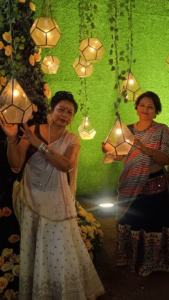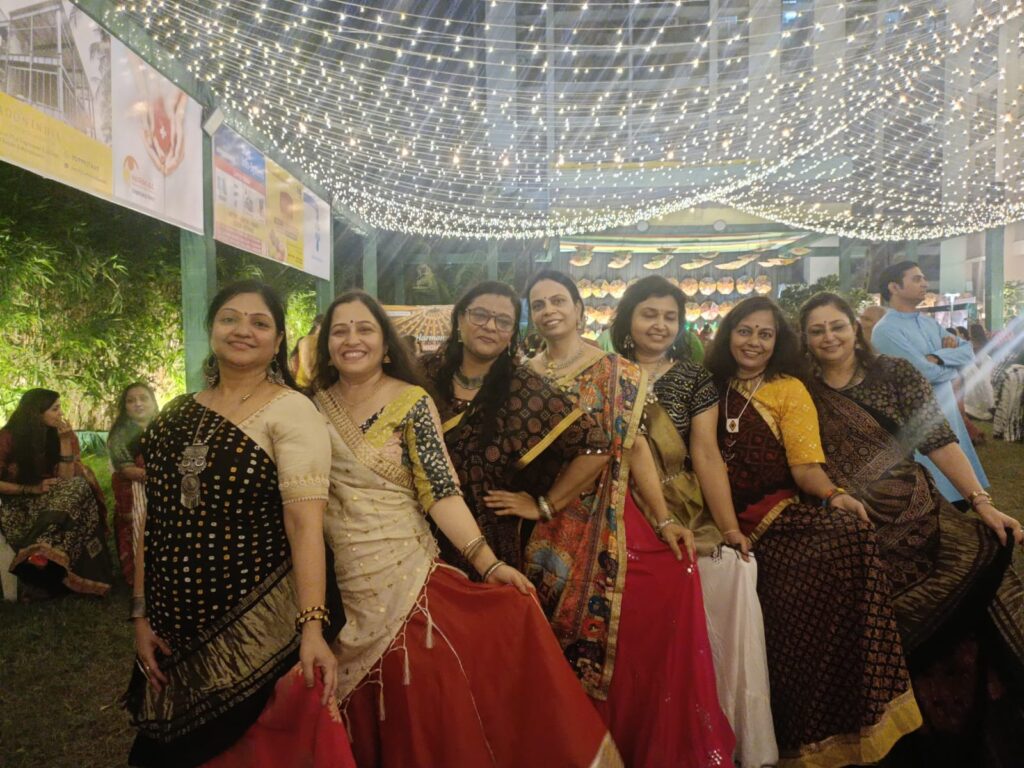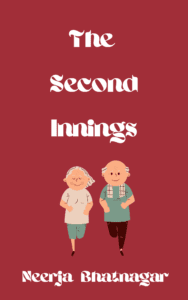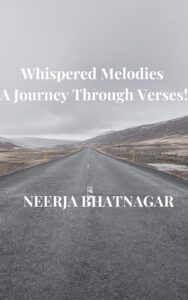
Just yesterday, we bid farewell to the vibrant nine-night festival of dance and devotion — Navratri. As the echoes of Garba songs and the swirling dance circles fade, it’s the perfect time to reflect on the rich history behind this beloved tradition. After all, understanding the legacy we’re carrying through this joyous celebration is as important as the dance itself. Garba is not just a performance; it’s a centuries-old tradition deeply tied to our cultural roots, and today, I want to take you through its fascinating journey.
The Evolution of Garba: From Tradition to Trend
Garba, a vibrant and deeply rooted dance form, is synonymous with the cultural essence of Gujarat. It transcends mere festivity, embodying centuries of religious and social significance, evolving through the ages into the modern-day spectacle it is. To truly understand Garba, we must delve into its origins, trace its journey, and explore how it has transitioned to the contemporary era while maintaining its traditional soul.
The Origins of Garba
The word “Garba” derives from the Sanskrit words ‘Garbha’ (womb) and ‘Deep’ (lamp), symbolizing life within the womb. Historically, Garba is performed to honour Goddess Durga, symbolizing feminine power and fertility. The dance was initially performed around a clay lantern called a ‘Garbha Deep’, representing the womb and life cycle. This circular movement of dancers around the light echoes the cycle of time: from birth, through life, to death, and rebirth.
Garba is traditionally associated with the worship of Goddess Durga and, specifically, the Navratri festival. During these nine nights, devotees would offer prayers and celebrate with the Garba, marking the triumph of good over evil. It is believed that Garba was influenced by old rituals of ‘Vrat’, a spiritual practice involving vows and fasting for religious purification and divine connection.

Garba, a traditional folk dance from Gujarat, has a rich history and has evolved significantly over the years. Its roots are often linked to the ancient traditions of goddess worship, where devotees would perform circular dances around a symbolic lamp, representing Durga or Amba, the mother goddess. This dance form is deeply intertwined with the spirit of Navratri, the nine-night festival dedicated to the divine feminine.
Interestingly, one story connects Garba to a lesser-known episode from the Mahabharata. During his time in exile, Arjuna, one of the Pandava brothers, took on the guise of a eunuch named Brihannala to avoid recognition. And learned women’s harem dance — hallisaka — a circular movement symbolising life, birth, and rebirth. This early dance mirrored the universe itself. This reference to Arjuna as a teacher of dance highlights a potential link between Garba and ancient dance traditions, although the connection is largely symbolic rather than direct.
Garba’s origins are also rooted in the Vedic period, where it symbolized the cycle of life, celebrating fertility, womanhood, and the divine feminine. The dance was traditionally performed by women in the inner courtyards of homes, and its movements were a form of worship and celebration of life.
Over time, Garba evolved from being a sacred dance form restricted to rituals to becoming a community-centric dance performed in large public spaces. In the 20th century, Garba started blending with the dandiya-raas, another traditional Gujarati dance involving sticks, adding new dynamics to the festival.

Today, modern Garba has transcended Gujarat and become a global phenomenon, with Garba events held in countries around the world, especially where the Gujarati diaspora resides. The music has incorporated contemporary beats, and the costumes have become more elaborate, blending traditional elements with modern fashion. The dance continues to thrive, retaining its cultural significance while adapting to the times.
Through all its transformations, Garba remains a dance of celebration, devotion, and community, symbolizing the enduring spirit of Gujarat’s cultural heritage.
Evolution through History
Garba has come a long way from its ritualistic origins. In ancient times, it was a simple devotional dance, mostly performed by women in temple courtyards. The attire was modest, and the music was traditional folk songs dedicated to the Goddess. Women performed Garba barefoot to maintain the sacred connection with the earth.
Over time, Garba began to move beyond the temple grounds and into community spaces, becoming a broader social and cultural event. With this shift, the dance also started to include men, and variations began to develop, such as the popular *Dandiya Raas*. While Garba is danced in circles, Dandiya involves the rhythmic clashing of sticks, representing the battle between Goddess Durga and the demon Mahishasura.
The Influence of Royal Patronage
During the medieval era, royal families in Gujarat began to patronize Garba, and the dance gradually gained a more formalized structure. This period saw the introduction of classical elements and formal musical accompaniments, elevating Garba from a simple folk dance to a more sophisticated performance art.
The involvement of the upper echelons of society also meant that Garba became a part of festive celebrations in palaces, bringing an element of grandeur to the tradition. Costumes became more elaborate, with women wearing traditional *Chaniya Cholis* adorned with mirrors and men donning Kediyu and Dhoti. Jewellery, too, became an essential part of the Garba attire, with both men and women adorning themselves with traditional silver ornaments.
Garba in the Modern Era
The 20th century witnessed a significant transformation of Garba, as it began to attract global attention. With the rise of Bollywood and the global Indian diaspora, Garba started to be featured in films and cultural programs, helping spread its popularity beyond Gujarat. In the 1980s and 1990s, Garba found a new audience with the introduction of fusion music, where traditional beats were mixed with contemporary rhythms, allowing younger generations to connect with the age-old dance.
The dance, once confined to temple rituals and community gatherings, exploded onto the commercial scene. The rise of organized Garba events in cities like Ahmedabad, Surat, and Vadodara turned Garba into a spectacle, complete with competitions, elaborate stage setups, and celebrity performances. Navratri Garba nights in urban settings today feature DJs mixing folk songs with techno beats, live orchestras, and professional dancers adding a modern flair to the traditional steps.

Costume Revolution
The traditional costumes have also transformed. While the core elements of *Chaniya Choli* and *Kediyu* remain, designers have modernized them with new fabrics, vibrant colours, and intricate embroidery. Many dancers today mix traditional Garba attire with modern outfits, creating a blend of cultural heritage and contemporary fashion.
Garba Goes Global
The global Indian diaspora has played a vital role in taking Garba to the international stage. Major cities in the USA, UK, Canada, and Australia now host grand Navratri Garba events. These international celebrations not only keep cultural traditions alive for non-resident Gujaratis but also introduce the rich heritage of Garba to a global audience. The non-Indian participants at these events showcase how Garba has evolved into a universal symbol of joy and togetherness.
Garba and Social Change
Beyond the glitz and glamour, Garba has also been a platform for social expression. Over the years, the dance has been used as a medium to address social issues, promote cultural integration, and celebrate diversity. In recent times, inclusive Garba events have emerged where people from all walks of life, regardless of gender, caste, or religion, come together to participate in the celebrations.
In 2020, with the onset of the global pandemic, Garba adapted to the virtual space. People from around the world participated in online Garba events via Zoom and other platforms, showcasing the dance’s resilience and adaptability in the face of challenges. Even in the digital age, the spirit of Garba remains alive, proving that it is more than just a dance—it is a cultural movement.
The Spirit of Garba

From its humble beginnings as a devotional dance in temple courtyards to its modern-day avatar as a global cultural phenomenon, Garba has undergone a remarkable transformation. Yet, at its core, it remains a dance of joy, unity, and devotion. Whether it’s the simple clapping of hands in a village square or the dazzling lights and sound of a grand urban event, Garba continues to be a celebration of life, keeping the rich cultural heritage of Gujarat alive through every beat and twirl.
![]()
As we look to the future, Garba will undoubtedly continue to evolve, blending tradition with innovation, but it will always remain a dance that brings people together in celebration of life and culture.
Neerja Bhatnagar
Feel free to connect with me on social media if you’d like to stay updated on more content like this!
Instagram | Facebook | YouTube |Twitter |Podcast |
I have written 3 solo books and 3 anthologies. You can buy my books on Amazon. If you are on Kindle Unlimited, you can read them for free. Pls, do check and share your reviews.




Very nice Neerja ji….bahut hi khubsurat words maine khubsurat..moj ..masti ..bhakti …Shakti wala festival ko described kiya aapne..
9 days…..maa ki bhakti …or ….garbe ki masti…dosto ke sath ….
Love nd wishes ❤️❤️🎉🎉
Thankyou Nupur! Yes, it was fun catching up with friends and enjoying the beats.
A very interesting article . Read through the pages and came to know many facts which were not known . The origin of garbha and the importance of earthen ware , is interesting . These nine days rather nine nights are simply unique of Gujarat , there is an electrifying atmosphere in the air , men women young and old dance till early dawn and continue later in the day with their office , business and schools etc . It S truly amazing .
Thanks Neerja for writing a lovely piece
Thank you Madhuji. You are always motivating.